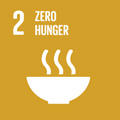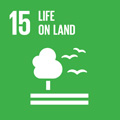- Docente: Elisabetta Frascaroli
- Credits: 6
- SSD: AGR/07
- Language: Italian
- Teaching Mode: Traditional lectures
- Campus: Bologna
- Corso: First cycle degree programme (L) in Agricultural Technology (cod. 5832)
-
from Feb 19, 2025 to May 15, 2025
Learning outcomes
This course gives the basis of Mendelian genetics, quantitative genetics, population genetics, and of the main biotechnological applications. The course gives also some example of plant breeding, to understand the economic importance of genetics and the relevance of the management genetic resources in sustainable agriculture.
Course contents
PREREQUISITES
The student taking this course possesses elementary knowledge of chemistry, biology, mathematics, and statistics. This knowledge is acquired in high school and in the basic courses taught during the first semester of the first year of study, with which this course is coordinated.
CONTENT OF CLASSROOM ACTIVITIES
1. Introduction and presentation of the contents, materials, and examination methods (1 hour)
2. Molecular basis of the replication of genetic information and its expression (5 hours)
- Inheritance and hereditary material. Composition and replication of DNA. DNA analysis: electrophoresis, restriction and ligation, PCR.
- Gene and its expression: RNA and transcription of the message. Genetic code and translation of the message. Gene regulation: central dogma of molecular biology.
Knowledge acquired in unit 2:
Structure of genetic material and how it can be replicated (DNA) or transcribed and translated (RNA). Principles underlying the use of DNA for diagnostic, forensic, or commercial purposes. Principles of gene expression and main modes of regulation.
3. Transmission of hereditary material: Mendel's experiments, gene association, and genetic maps (6 hours)
(integration with the biology course: reproduction; mitosis and meiosis; integration with the statistics course: probability; Chi-square test).
- Transmission of hereditary material: sexual reproduction, recombination, genetic aspects of mitosis and meiosis.
- Mendel's experiments: dominance, segregation, independent assortment.
- Gene association: recombination at linked loci (crossing-over), verification of loci independence with Chi-square test. Association maps and genetic markers.
Knowledge acquired in unit 3:
Modes of hereditary transmission of Mendelian traits. Role of sexual reproduction in recombination. Construction of genetic maps.
4. The dynamic genome: main modifications of hereditary material and genetic engineering (8 hours)
- Spontaneous mutations: gene, chromosomal, and genomic. Evolutionary processes through polyploidy (case of the Triticum genus).
- Elements of genetic engineering. Techniques of assisted evolution: gene editing.
Knowledge acquired in unit 4:
Main modifications of hereditary material (mutations). Origin of genetic variability. Genetic transformation of plants and other means to induce useful variability.
5. Inheritance of quantitative traits (4 hours)
(integration with the statistics course: mean and variance).
- Johannsen experiments, genotypic effect, and environmental effect, economic importance of quantitative traits.
- Analysis of the components of the mean and variance. Inbreeding and heterosis.
Knowledge acquired in unit 5:
Hereditary transmission of traits of agronomic and economic interest determined by complex multifactorial genes.
6. Population genetics (6 hours)
- Hardy-Weinberg law. Factors of equilibrium: mutations, migration, selection, non-random mating, population size (genetic drift).
- Genetic erosion. Conservation of intraspecific genetic biodiversity, evolution.
Knowledge acquired in unit 6:
Genetic aspects of natural and artificial populations. Causes of variations in allele and genotype frequencies. Genetic aspects underlying the conservation of intraspecific biodiversity.
7. Evolution, genetic improvement, and valorization of biodiversity (6 hours)
- Brief notes on domestication of cultivated plants: history of genetic improvement. Genetic improvement in self-pollinating and cross-pollinating plants.
- Brief notes on the management of genetic improvement programs, on genetics in seed production, and on seed trade.
Knowledge acquired in unit 7:
Genetic aspects in artificial selection and seed dissemination.
8. Activities carried out during practical sessions (24 hours)
- Demonstrations of simple DNA analyses,
- Examination of data collected by students or simulated by the teacher and simple statistical analysis,
- Group activities: how to find and evaluate information in the genetic field, critical analysis guided by the teacher and conducted by students, writing reports, and presenting brief seminars.
Knowledge acquired in unit 8:
- Familiarity with the results of diagnostic analyses useful for forensic or commercial purposes.
- Acquisition of the scientific method in genetics through statistical verification of data.
- Ability to independently acquire new information, using critical and source verification skills, partly in English.
- Experience in teamwork and public communication of technical reports.
Readings/Bibliography
One of the following:
M. Busconi e altri. Genetica agraria, EdiSES, Napoli, 2016
F. Lorenzetti et al. Genetica agraria - Genetica e biotecnologie applicate all'agricoltura. Patron, Bologna, 2011.
G. Barcaccia, M. Falcinelli. Genetica e genomica, Vol I genetica vegetale, Liguori Napoli, 2005; G. Barcaccia, M. Falcinelli. Genetica e genomica, Vol II miglioramento genetico, Liguori Napoli, 2005.
Notes from the course available on line through the Moodle platform (iol): Conceptual frameworks from classes, datasets used in practicals, collection of students works and of short reports, groups support for seminar organization.
Literature and notes in English will be provided upon request.
Teaching methods
The course consists of 36 hours of teaching assisted by the projection of slides, animations and videos, and 24 hours of hours of tutorials (practical classes) in didactic / demonstration fields and in the classroom. Tutoring activity will assist student's progress, especially for those who are not familiar with bases of genetics fron pevious studies.
The frontal teaching is aimed at illustrating the subjects and at stimulating the involvement of students to verify previous knowledge, the level of learning of the new topics and to promote a critical discussion of the topics covered. Particularly interesting topics, related to the subjects covered in the class, will also be explored in group discussions, case study examination and seminars.
The exercises aim to make students familiar with the results of diagnostic analyses, and with the scientific method in the genetic field, by means of statistical data verification. It is also intended to stimulate the ability to criticize and verify the sources of informtion, partly in English. Last but not least, the aim of practical classes is to promote teamwork and public communication of technical documents.Assessment methods
The exam can be taken in English, upon request.
The written exam consists of a test of 34 closed-ended, multiple-choice questions (each question has 4 answers of which only one is correct) and 3 open questions on the course topics. For each correct answer to the closed questions 0.5 points are attributed, for each open question 0 to 5 points can be attributed. For all students who have obtained a score at least sufficient in the written test (18), it is also possible to add the points acquired in the practical activities (report and seminar), as specified in the program (for a maximum of 4 points).
Teaching tools
Personal computer and projector for classroom activities.
Scientific literature provived by the Sistema Bibiliografico di Ateneo and provided through VIRTUALE platform.
Blog/forum for discussion teacher-students on VIRTUALE platform, accessible to the course student only.
Self-evaluation quizzes in VIRTUALE platform for assisting the larning process and for trying the final exam.
The conceptual framework presented in classes and notes explaning how to approach textbooks will be made available to the students through VIRTUALE platform.
Office hours
See the website of Elisabetta Frascaroli
SDGs




This teaching activity contributes to the achievement of the Sustainable Development Goals of the UN 2030 Agenda.
